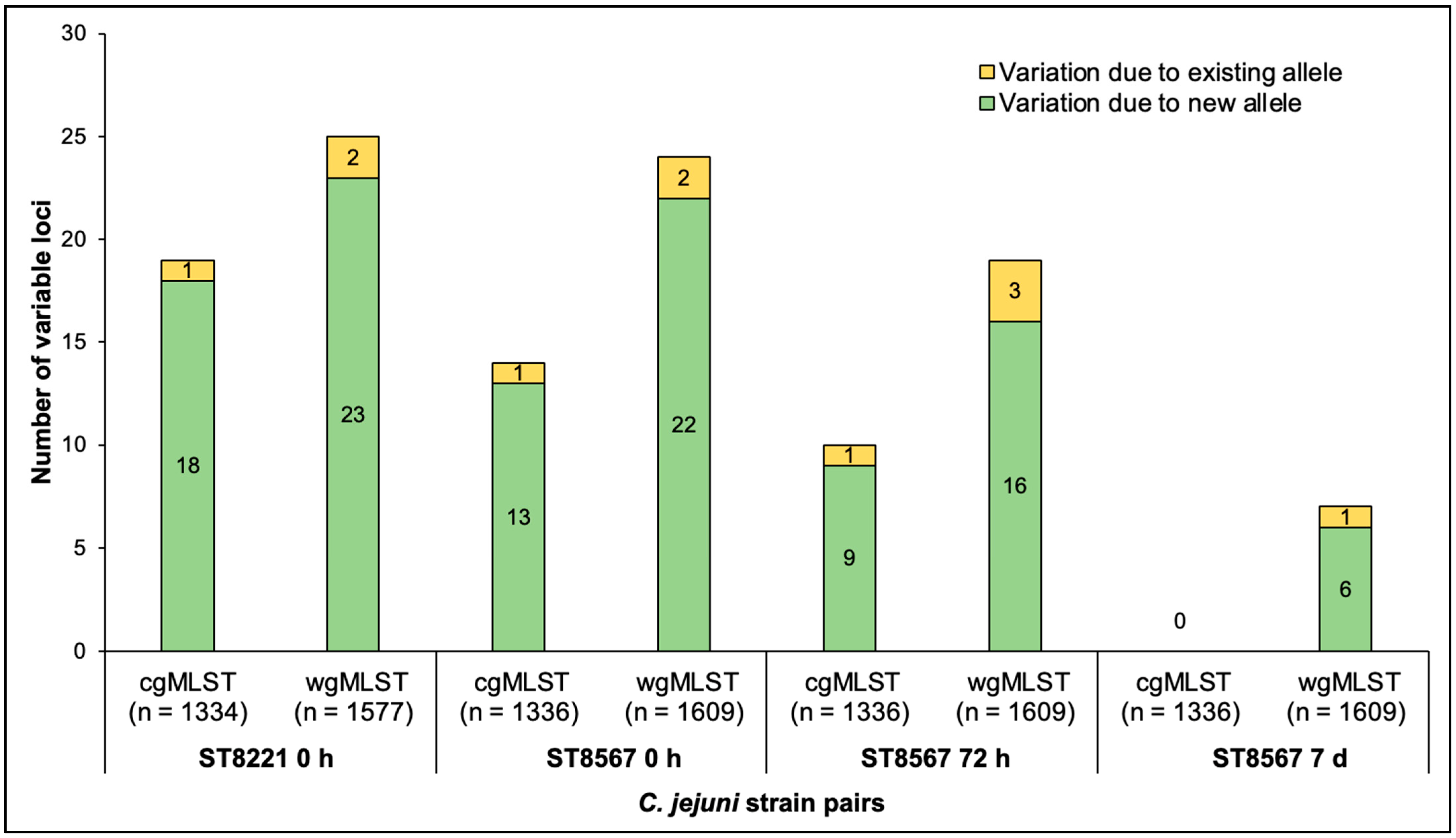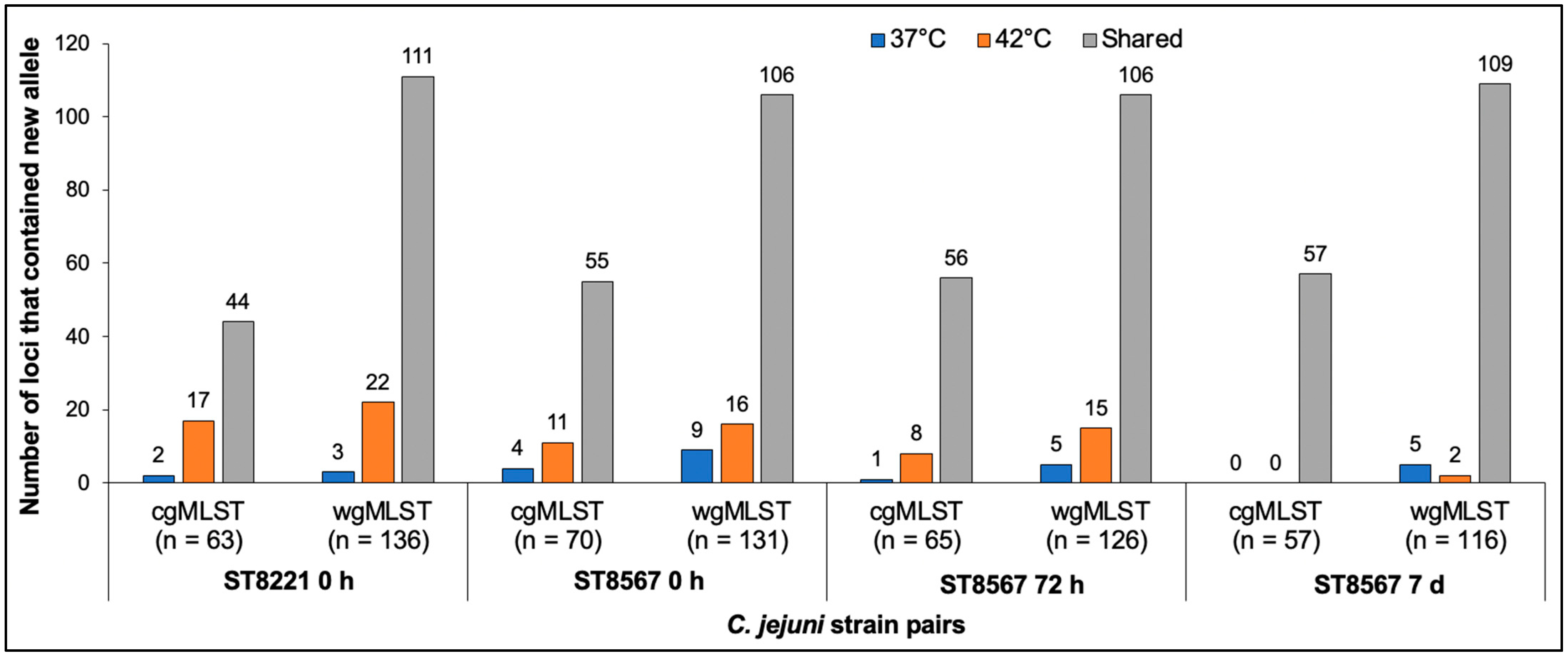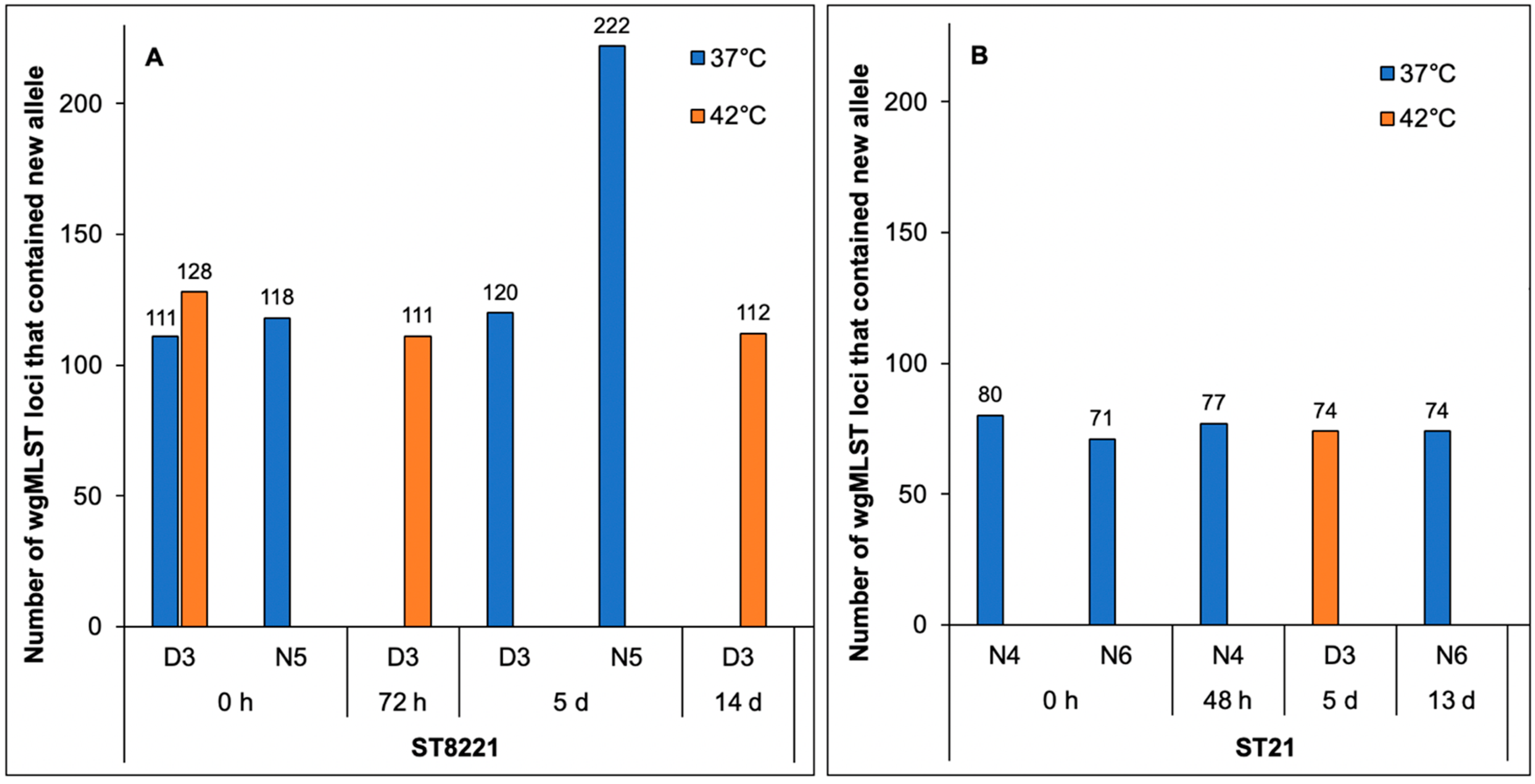Genomic Analysis Reveals That Isolation Temperature on Selective Media Introduces Genetic Variation in Campylobacter jejuni from Bovine Feces
Abstract
:1. Introduction
2. Results and Discussion
2.1. C. jejuni Strains and Quality of WGS
2.2. Variable Loci at the Different Temperatures Were Identified in Both STs, with Overall Higher Prevalence of Variable New Alleles at 42 °C Than 37 °C
2.3. Missense and Frameshift Mutations Predominated among the Variable Loci
2.4. Variation in HTs Is Predominant among the Variable Loci
2.5. Certain Variable Loci Were Encountered in Strain Pairs from Different Time Points
2.6. Directions for Future Research
3. Materials and Methods
3.1. C. jejuni Strains and Culture Conditions
3.2. Whole Genome Sequencing (WGS), Assembly, and Annotation
3.3. cgMLST, wgMLST, and Single-Nucleotide Polymorphism (SNP) Cluster Analysis
3.4. Data Availability
Supplementary Materials
Author Contributions
Funding
Institutional Review Board Statement
Informed Consent Statement
Data Availability Statement
Acknowledgments
Conflicts of Interest
Disclaimer
References
- Tack, D.M.; Marder, E.P.; Griffin, P.M.; Cieslak, P.R.; Dunn, J.; Hurd, S.; Scallan, E.; Lathrop, S.; Muse, A.; Ryan, P.; et al. Preliminary incidence and trends of infections with pathogens transmitted commonly through food—Foodborne diseases active surveillance network, 10 U.S. sites, 2015–2018. MMWR 2019, 68, 369–373. [Google Scholar] [CrossRef] [PubMed]
- Silva, J.; Leite, D.; Fernandes, M.; Mena, C.; Gibbs, P.A.; Teixeira, P. Campylobacter spp. as a foodborne pathogen: A review. Front. Microbiol. 2011, 2, 200. [Google Scholar] [CrossRef] [PubMed]
- Young, K.T.; Davis, L.M.; Dirita, V.J. Campylobacter jejuni: Molecular biology and pathogenesis. Nat. Rev. Microbiol. 2007, 5, 665–679. [Google Scholar] [CrossRef] [PubMed]
- Wilson, D.J.; Gabriel, E.; Leatherbarrow AJ, H.; Cheesbrough, J.; Gee, S.; Bolton, E.; Fox, A.; Fearnhead, P.; Hart, C.A.; Diggle, P.J. Tracing the source of campylobacteriosis. PLoS Genet. 2008, 4, e1000203. [Google Scholar] [CrossRef] [PubMed]
- Aroori, S.V.; Cogan, T.A.; Humphrey, T.J. The effect of growth temperature on the pathogenicity of Campylobacter. Curr. Microbiol. 2013, 67, 333–340. [Google Scholar] [CrossRef]
- United States Department of Agriculture (USDA). Dairy 2007, Part II: Changes in the U.S. Dairy Cattle Industry, 1991–2007. 2008. Available online: https://naldc.nal.usda.gov/download/38398/PDF (accessed on 20 March 2022).
- United States Department of Agriculture (USDA). Feedlot 2011 Part IV: Health and Health Management on U.S. Feedlots with a Capacity of 1000 or More Head. 2013. Available online: https://www.aphis.usda.gov/animal_health/nahms/feedlot/downloads/feedlot2011/Feed11_dr_PartIV_1.pdf (accessed on 20 March 2022).
- United States Department of Agriculture (USDA). Dairy 2014, Milk Quality, Milking Procedures, and Mastitis in the United States, 2014. 2016. Available online: https://www.aphis.usda.gov/animal_health/nahms/dairy/downloads/dairy14/Dairy14_dr_Mastitis.pdf (accessed on 20 March 2022).
- Fan, S.; Foster, D.; Miller, W.G.; Osborne, J.; Kathariou, S. Impact of ceftiofur administration in steers on the prevalence and antimicrobial resistance of Campylobacter spp. Microorganisms 2021, 9, 318. [Google Scholar] [CrossRef]
- de Oliveira, M.G.; Rizzi, C.; Galli, V.; Lopes, G.V.; Haubert, L.; Dellagostin, O.A.; da Silva, W.P. Presence of genes associated with adhesion, invasion, and toxin production in Campylobacter jejuni isolates and effect of temperature on their expression. Can. J. Microbiol. 2019, 65, 253–260. [Google Scholar] [CrossRef]
- Stintzi, A. Gene expression profile of Campylobacter jejuni in response to growth temperature variation. J. Bacteriol. 2003, 185, 2009–2016. [Google Scholar] [CrossRef]
- Tang, Y.; Cawthraw, S.; Bagnall, M.C.; Gielbert, A.; Woodward, M.; Petrovska, L. Identification of temperature regulated factors of Campylobacter jejuni and their potential roles in virulence. AIMS Microbiol. 2017, 3, 885–898. [Google Scholar] [CrossRef]
- Zhang, M.J.; Xiao, D.; Zhao, F.; Gu, Y.X.; Meng, F.L.; He, L.H.; Ma, G.Y.; Zhang, J.Z. Comparative proteomic analysis of Campylobacter jejuni cultured at 37C and 42C. Jpn. J. Infect. Dis. 2009, 62, 356–361. [Google Scholar]
- Rokney, A.; Valinsky, L.; Vranckx, K.; Feldman, N.; Agmon, V.; Moran-Gilad, J.; Weinberger, M. WGS-based prediction and analysis of antimicrobial resistance in Campylobacter jejuni isolates from Israel. Front. Cell. Infect. Microbiol. 2020, 10, 365. [Google Scholar] [CrossRef] [PubMed]
- Neal-McKinney, J.M.; Liu, K.C.; Lock, C.M.; Wu, W.H.; Hu, J. Comparison of MiSeq, MinION, and hybrid genome sequencing for analysis of Campylobacter jejuni. Sci. Rep. 2021, 11, 5676. [Google Scholar] [CrossRef]
- Sorgentone, S.; Busani, L.; Calistri, P.; Robuffo, G.; Bellino, S.; Acciari, V.; Ferri, M.; Graziani, C.; Antoci, S.; Lodi, F.; et al. A large food-borne outbreak of campylobacteriosis in kindergartens and primary schools in Pescara, Italy, May-June 2018. J. Med. Microbiol. 2021, 70. [Google Scholar] [CrossRef] [PubMed]
- Barker, C.R.; Painset, A.; Swift, C.; Jenkins, C.; Godbole, G.; Maiden MC, J.; Dallman, T.J. Microevolution of Campylobacter jejuni during long-term infection in an immunocompromised host. Sci. Rep. 2020, 10, 10109. [Google Scholar] [CrossRef] [PubMed]
- Versace, G.; Palombo, M.; Menon, A.; Scarlato, V.; Roncarati, D. Feeling the heat: The Campylobacter jejuni HrcA transcriptional repressor is an intrinsic protein thermosensor. Biomolecules 2021, 11, 1413. [Google Scholar] [CrossRef] [PubMed]
- Hazeleger, W.C.; Wouters, J.A.; Rombouts, F.M.; Abee, T. Physiological activity of Campylobacter jejuni far below the minimal growth temperature. Appl. Environ. Microbiol. 1998, 64, 3917–3922. [Google Scholar] [CrossRef]
- On, S.L.W.; Miller, W.G.; Houf, K.; Fox, J.G.; Vandamme, P. Minimal standards for describing new species belonging to the families Campylobacteraceae and Helicobacteraceae: Campylobacter, Arcobacter, Helicobacter and Wolinella spp. Int. J. Syst. Evol. 2017, 67, 5296–5311. [Google Scholar] [CrossRef]
- Skarp, C.P.A.; Akinrinade, O.; Kaden, R.; Johansson, C.; Rautelin, H. Accessory genetic content in Campylobacter jejuni ST21CC isolates from feces and blood. Int. J. Med. Microbiol. 2017, 307, 233–240. [Google Scholar] [CrossRef]
- Clark, C.G.; Berry, C.; Walker, M.; Petkau, A.; Barker, D.O.R.; Guan, C.; Reimer, A.; Taboada, E.N. Genomic insights from whole genome sequencing of four clonal outbreak Campylobacter jejuni assessed within the global C. jejuni population. BMC Genom. 2016, 17, 990. [Google Scholar] [CrossRef]
- Cody, A.J.; McCarthy, N.D.; Jansen van Rensburg, M.; Isinkaye, T.; Bentley, S.D.; Parkhill, J.; Dingle, K.E.; Bowler, I.C.W.; Jolley, K.A.; Maiden, M.C.J. Real-time genomic epidemiological evaluation of human Campylobacter isolates by use of whole-genome multilocus sequence typing. J. Clin. Microbiol. 2013, 51, 2526–2534. [Google Scholar] [CrossRef]
- Jerome, J.P.; Bell, J.A.; Plovanich-Jones, A.E.; Barrick, J.E.; Brown, C.T.; Mansfield, L.S. Standing genetic variation in contingency loci drives the rapid adaptation of Campylobacter jejuni to a novel host. PLoS ONE 2011, 6, e16399. [Google Scholar] [CrossRef] [PubMed]
- Revez, J.; Schott, T.; Llarena, A.-K.; Rossi, M.; Hänninen, M.L. Genetic heterogeneity of Campylobacter jejuni NCTC 11168 upon human infection. Infect. Genet. Evol. 2013, 16, 305–309. [Google Scholar] [CrossRef] [PubMed]
- Revez, J.; Zhang, J.; Schott, T.; Kivistö, R.; Rossi, M.; Hänninen, M.L. Genomic variation between Campylobacter jejuni isolates associated with milk-borne-disease outbreaks. J. Clin. Microbiol. 2014, 52, 2782–2786. [Google Scholar] [CrossRef] [PubMed]
- Thomas, D.K.; Lone, A.G.; Selinger, L.B.; Taboada, E.N.; Uwiera, R.R.E.; Abbott, D.W.; Inglis, G.D. Comparative variation within the genome of Campylobacter jejuni NCTC 11168 in human and murine hosts. PLoS ONE 2014, 9, e88229. [Google Scholar] [CrossRef]
- Poli, V.F.S.; Thorsen, L.; Olesen, I.; Wik, M.T.; Jespersen, L. Differentiation of the virulence potential of Campylobacter jejuni strains by use of gene transcription analysis and a Caco-2 assay. Int. J. Food Microbiol. 2012, 155, 60–68. [Google Scholar] [CrossRef]
- Parkhill, J.; Wren, B.W.; Mungall, K.; Ketley, J.M.; Churcher, C.; Basham, D.; Chillingworth, T.; Davies, R.M.; Feltwell, T.; Holroyd, S.; et al. The genome sequence of the food-borne pathogen Campylobacter jejuni reveals hypervariable sequences. Nature 2000, 403, 665–668. [Google Scholar] [CrossRef]
- Dunn, S.J.; Pascoe, B.; Turton, J.; Fleming, V.; Diggle, M.; Sheppard, S.K.; McNally, A.; Manning, G. Genomic epidemiology of clinical Campylobacter spp. at a single health trust site. Microb. Genom. 2018, 4, e000227. [Google Scholar] [CrossRef]
- Fagerlund, A.; Langsrud, S.; Møretrø, T. In-depth longitudinal study of Listeria monocytogenes ST9 isolates from the meat processing industry: Resolving diversity and transmission patterns using whole-genome sequencing. Appl. Environ. Microbiol. 2020, 86, e00579-20. [Google Scholar] [CrossRef]
- Zhao, S.; Tyson, G.H.; Chen, Y.; Li, C.; Mukherjee, S.; Young, S.; Lam, C.; Folster, J.P.; Whichard, J.M.; McDermott, P.F. Whole-genome sequencing analysis accurately predicts antimicrobial resistance phenotypes in Campylobacter spp. Appl. Environ. Microbiol. 2015, 82, 459–466. [Google Scholar] [CrossRef]
- Nurk, S.; Bankevich, A.; Antipov, D.; Gurevich, A.A.; Korobeynikov, A.; Lapidus, A.; Prjibelski, A.D.; Pyshkin, A.; Sirotkin, A.; Sirotkin, Y.; et al. Assembling single-cell genomes and mini-metagenomes from chimeric MDA products. J. Comput. Biol. 2013, 20, 714–737. [Google Scholar] [CrossRef]
- Aziz, R.K.; Bartels, D.; Best, A.A.; DeJongh, M.; Disz, T.; Edwards, R.A.; Formsma, K.; Gerdes, S.; Glass, E.M.; Kubal, M.; et al. The RAST Server: Rapid annotations using subsystems technology. BMC Genom. 2008, 9, 75. [Google Scholar] [CrossRef] [PubMed]
- Overbeek, R.; Begley, T.; Butler, R.M.; Choudhuri, J.V.; Chuang, H.Y.; Cohoon, M.; de Crécy-Lagard, V.; Diaz, N.; Disz, T.; Edwards, R.; et al. The subsystems approach to genome annotation and its use in the project to annotate 1000 genomes. Nucleic Acids Res. 2005, 33, 5691–5702. [Google Scholar] [CrossRef] [PubMed]
- Jolley, K.A.; Bray, J.E.; Maiden, M.C.J. Open-access bacterial population genomics: BIGSdb software, the PubMLST.org website and their applications. Wellcome Open Res. 2018, 3, 124. [Google Scholar] [CrossRef] [PubMed]
- Davis, J.J.; Wattam, A.R.; Aziz, R.K.; Brettin, T.; Butler, R.; Butler, R.M.; Chlenski, P.; Conrad, N.; Dickerman, A.; Dietrich, E.M.; et al. The PATRIC bioinformatics resource center: Expanding data and analysis capabilities. Nucleic Acids Res. 2020, 48, D606–D612. [Google Scholar] [CrossRef]




| Strain | Temperature (°C) | ST 3 | Steer | Time 4 | SNP Cluster | Accession | BioSample | SRA Accession |
|---|---|---|---|---|---|---|---|---|
| D3-0h-37-A 1 | 37 | 8221 | D3 | 0 h | PDS000091235.1 | PDT001064031.1 | SAMN19009706 | SRS8893461 |
| D3-0h-42-A 1 | 42 | 8221 | D3 | 0 h | PDS000091235.1 | PDT001064029.1 | SAMN19009708 | SRS8893463 |
| N5-0h-37-A | 37 | 8221 | N5 | 0 h | PDS000091235.1 | PDT001064064.1 | SAMN19009714 | SRS8893428 |
| D3-72h-42-A | 42 | 8221 | D3 | 72 h | PDS000091235.1 | PDT001064028.1 | SAMN19009709 | SRS8893464 |
| D3-5d-37-A | 37 | 8221 | D3 | 5 d | PDS000091235.1 | PDT001064030.1 | SAMN19009707 | SRS8893462 |
| N5-5d-37-B | 37 | 8221 | N5 | 5 d | PDS000091235.1 | PDT001064063.1 | SAMN19009715 | SRS8893429 |
| D3-14d-42-A | 42 | 8221 | D3 | 14 d | PDS000091235.1 | PDT001064067.1 | SAMN19009711 | SRS8893426 |
| D2-0h-37-D 2 | 37 | 8567 | D2 | 0 h | PDS000091234.1 | PDT001064070.1 | SAMN19009700 | SRS8893422 |
| D2-0h-42-A 2 | 42 | 8567 | D2 | 0 h | PDS000091234.1 | PDT001064047.1 | SAMN19009703 | SRS8893445 |
| D2-72h-37-A 2 | 37 | 8567 | D2 | 72 h | PDS000091234.1 | PDT001064069.1 | SAMN19009701 | SRS8893423 |
| D2-72h-42-C 2 | 42 | 8567 | D2 | 72 h | PDS000091234.1 | PDT001064036.1 | SAMN19009704 | SRS8893456 |
| D2-7d-37-A 2 | 37 | 8567 | D2 | 7 d | PDS000091234.1 | PDT001064058.1 | SAMN19009702 | SRS8893434 |
| D2-7d-42-A’ 2 | 42 | 8567 | D2 | 7 d | PDS000091234.1 | PDT001064032.1 | SAMN19009705 | SRS8893460 |
| N4-0h-37-A | 37 | 21 | N4 | 0 h | PDS000091232.1 | PDT001064066.1 | SAMN19009712 | SRS8893425 |
| N6-0h-37-A | 37 | 21 | N6 | 0 h | PDS000091232.1 | PDT001064062.1 | SAMN19009716 | SRS8893430 |
| N4-48h-37-C | 37 | 21 | N4 | 48 h | PDS000091232.1 | PDT001064065.1 | SAMN19009713 | SRS8893427 |
| D3-5d-42-A | 42 | 21 | D3 | 5 d | PDS000091232.1 | PDT001064068.1 | SAMN19009710 | SRS8893424 |
| N6-13d-37-A’ | 37 | 21 | N6 | 13 d | PDS000091232.1 | PDT001064061.1 | SAMN19009717 | SRS8893431 |
| Strain Pair | Number of VL | Impacts on the Deduced Polypeptide Sequences | |||||||
|---|---|---|---|---|---|---|---|---|---|
| Missense | Silent | Frameshift | Nonsense | Start-Loss | |||||
| Number of VL 1 | Number of VL 1 | Number of VL 1 | Locus 1, 2, 3 | Number of VL 1 | Locus 1, 2 | Number of VL 1 | Locus 1, 2, 3 | ||
| ST8221 0 h 4 | 25 | 15 | 1 | 2 (1L, 1H) | CAMP0341, 5A, H CAMP0575, 10G, L | 3 (3H) | CAMP0028, H CAMP1605, 8A, H CAMP1680, H | 3 (3H) | CAMP0342, H CAMP0912, H CAMP0926, 6T, H |
| ST8567 0 h | 24 | 14 | 1 | 10 (3L, 5H, 1H, 1HL) | CAMP1214, 11G, HL CAMP1261, 8A, H CAMP0044, 10G, L CAMP0575, 11G, L CAMP1223 4, 11G, H CAMP1228, 9G, H CAMP1243, 11G, H CAMP1258, 10G, H CAMP1644, 9G, H CAMP1649, 10G, L | 0 | 0 | 1 (1H) | CAMP0912, H |
| ST8567 72 h 4 | 19 | 11 | 5 | 5 (2L, 1L, 1H, 1H) | CAMP0260, 9T, L CAMP0044, 10G, L CAMP0827, H CAMP1331, 10G, H CAMP1644, 10G, L | 1 (1H) | CAMP0345, 5A, H | 0 | 0 |
| ST8567 7 d | 7 | 3 | 0 | 4 (1L, 2H, 1HL) | CAMP0044, 10G, H CAMP1243, 10G, L CAMP1258, 9G, H CAMP1644, 10G, HL | 0 | 0 | 0 | 0 |
Publisher’s Note: MDPI stays neutral with regard to jurisdictional claims in published maps and institutional affiliations. |
© 2022 by the authors. Licensee MDPI, Basel, Switzerland. This article is an open access article distributed under the terms and conditions of the Creative Commons Attribution (CC BY) license (https://creativecommons.org/licenses/by/4.0/).
Share and Cite
Fan, S.; Foster, D.; Zhao, S.; Mukherjee, S.; Shrestha, Y.; Parsons, C.; Kathariou, S. Genomic Analysis Reveals That Isolation Temperature on Selective Media Introduces Genetic Variation in Campylobacter jejuni from Bovine Feces. Pathogens 2022, 11, 678. https://doi.org/10.3390/pathogens11060678
Fan S, Foster D, Zhao S, Mukherjee S, Shrestha Y, Parsons C, Kathariou S. Genomic Analysis Reveals That Isolation Temperature on Selective Media Introduces Genetic Variation in Campylobacter jejuni from Bovine Feces. Pathogens. 2022; 11(6):678. https://doi.org/10.3390/pathogens11060678
Chicago/Turabian StyleFan, Sicun, Derek Foster, Shaohua Zhao, Sampa Mukherjee, Yesha Shrestha, Cameron Parsons, and Sophia Kathariou. 2022. "Genomic Analysis Reveals That Isolation Temperature on Selective Media Introduces Genetic Variation in Campylobacter jejuni from Bovine Feces" Pathogens 11, no. 6: 678. https://doi.org/10.3390/pathogens11060678
APA StyleFan, S., Foster, D., Zhao, S., Mukherjee, S., Shrestha, Y., Parsons, C., & Kathariou, S. (2022). Genomic Analysis Reveals That Isolation Temperature on Selective Media Introduces Genetic Variation in Campylobacter jejuni from Bovine Feces. Pathogens, 11(6), 678. https://doi.org/10.3390/pathogens11060678







